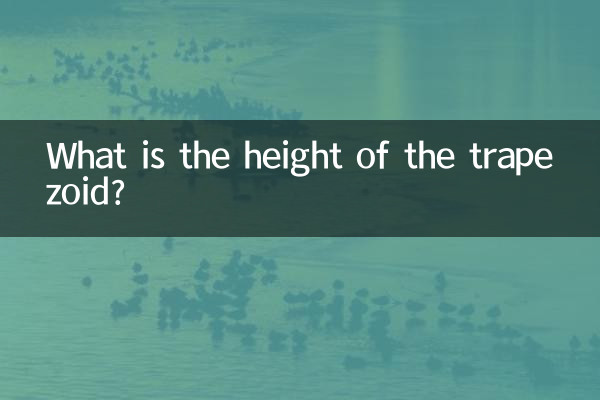What is the height of the trapezoid?
In geometry, trapezoidal shape is a common quadrilateral shape with two parallel sides called base and top edge. The height of a trapezoid refers to the vertical distance between two parallel sides, that is, the line segment extending vertically from one bottom edge to the other bottom edge. Understanding the height of a trapezoid is crucial to calculating its area.
This article will combine popular topics and hot contents across the network for the past 10 days to discuss the height of trapezoids and their related applications, and display relevant information through structured data.

1. Basic concept of trapezoidal shape
A trapezoid is a quadrilateral in which only one set of opposite sides is parallel. The two parallel sides are called the upper bottom and the lower bottom respectively, and the two non-parallel sides are called the waist. The height of a trapezoid is a line segment that extends vertically from one bottom edge to another, and its length determines the area of the trapezoid.
The area formula of the trapezoid is:Area = (upper bottom + lower bottom) × height ÷ 2. Therefore, understanding the height of the trapezoid is the key to solving geometric problems.
2. The relationship between popular topics and trapezoidal height in the entire network in the past 10 days
The following are some of the content related to geometry in the popular topics on the entire network in the past 10 days, displayed in the form of a table:
| Hot Topics | Related content | Popularity index |
|---|---|---|
| Mathematics Education Innovation | How to improve students' spatial thinking ability through the concept of trapezoidal height | 85 |
| Geometry application | Practical application cases of trapezoidal height in architectural design | 78 |
| Online learning tools | Recommend several mathematical software to help understand trapezoidal height | 92 |
| STEM Education | The importance of trapezoidal height in STEM courses and teaching methods | 88 |
3. Practical application of trapezoidal height
The height of trapezoids is not only of great significance in mathematics learning, but also has wide application in real life. For example:
1.Architectural Design: Many buildings have roof or staircase designs that adopt trapezoidal structures, and the calculation of trapezoidal height directly affects the stability and aesthetics of the building.
2.Engineering Measurement: In road or bridge construction, measuring trapezoidal height is an important part of ensuring engineering accuracy.
3.Art creation: The perspective effect in many works of art depends on the concept of trapezoidal height, especially three-dimensional paintings and sculptures.
4. How to calculate the height of the trapezoid
The height of the trapezoid can be calculated by the following methods:
| method | step | Applicable conditions |
|---|---|---|
| Area inverse method | The area of the trapezoid and the length of the upper and lower bottom are known, and the area formula is reversely pushed up. | Known area and bottom edge |
| Pythagorean Theorem Method | The right triangle is constructed by the waist and bottom edge difference of the trapezoid, and the height is calculated using the Pythagorean theorem. | Known waist and bottom edge difference |
| Coordinate system method | Determine the coordinates of trapezoidal vertex in the coordinate system and calculate the height by the vertical distance formula | Known vertex coordinates |
5. Summary
The height of trapezoids is a basic concept in geometry, but its importance cannot be ignored. It not only relates to the area calculation of trapezoids, but also has wide application in real life. Through the structured data display and content analysis of this article, I hope it can help readers better understand the definition, calculation methods and application scenarios of trapezoidal height.
If you have more questions about the height or other geometric concepts of trapezoids, you can refer to recent popular math education topics, or use online learning tools to explore further.

check the details

check the details